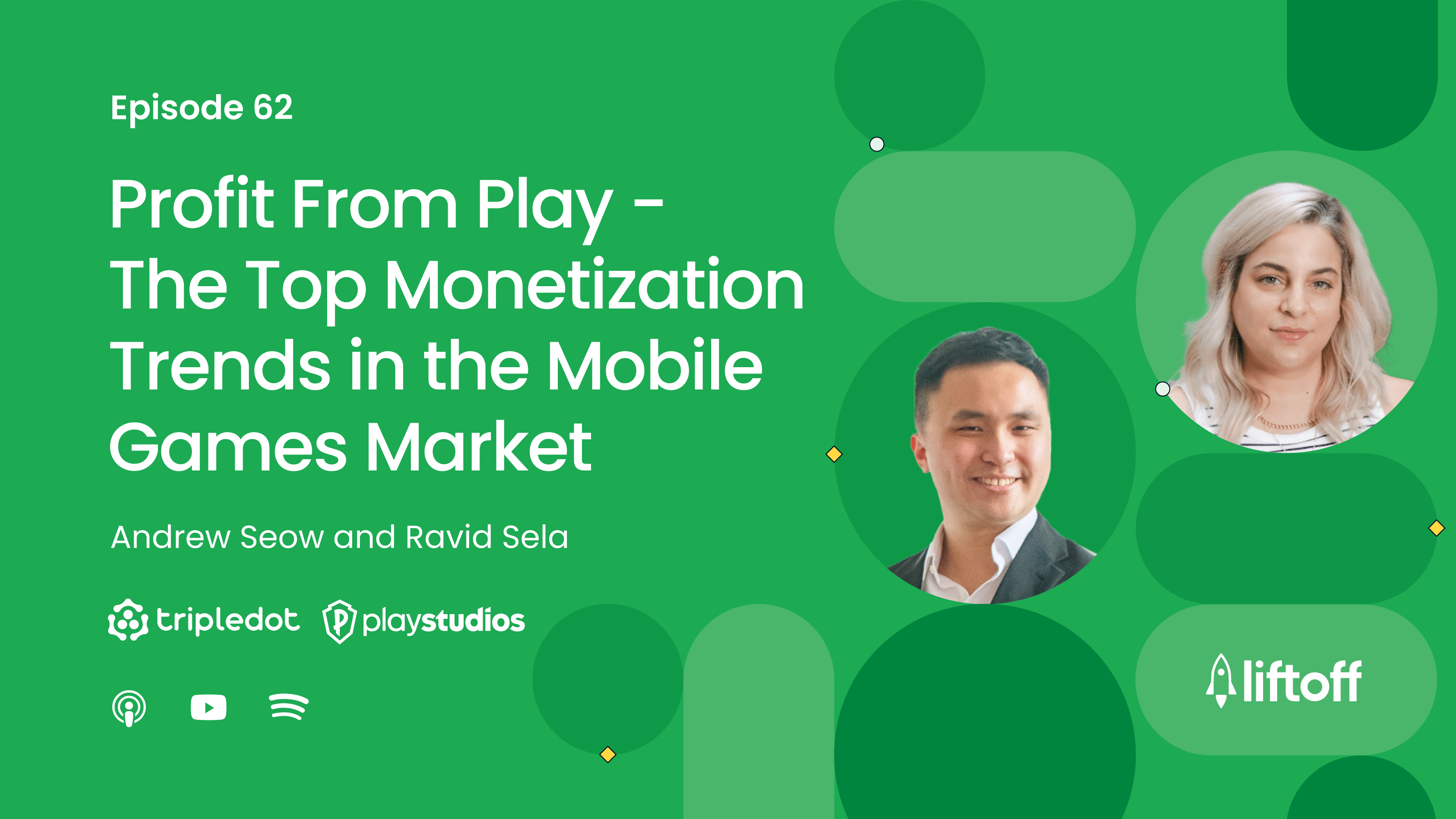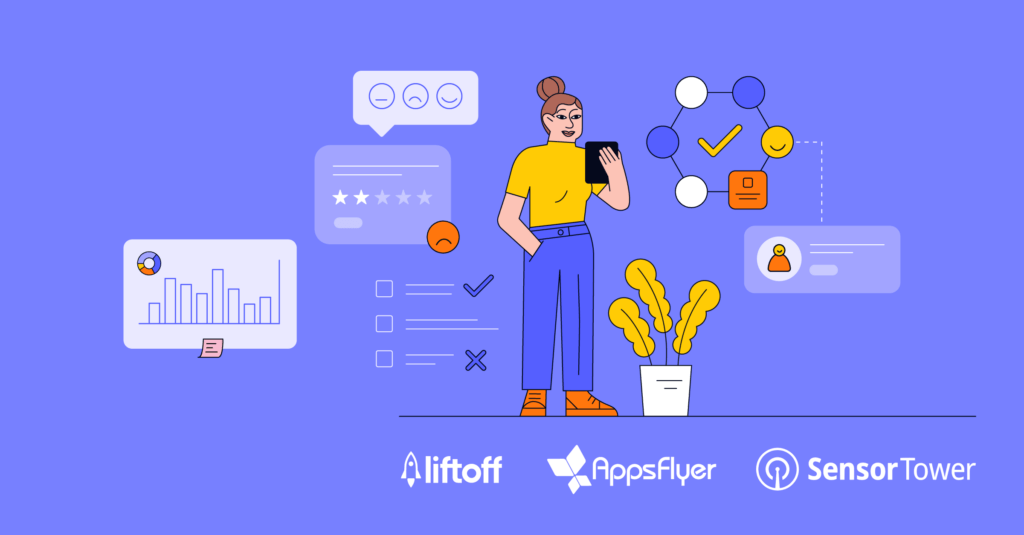This episode of the Mobile Games Playbook explores current monetization trends in mobile gaming and touches on subjects such as hybrid monetization, header bidding, and the challenges of in-app purchases.
![]() Spotify, BuzzSprout, TuneInRadio, iHeartRadio
Spotify, BuzzSprout, TuneInRadio, iHeartRadio
– If you enjoy the episode, remember to hit subscribe!
Join Andrew Seow (Director of Monetization at Tripledot Studios) and Ravid Sela (Ad Monetization Lead at Play Studios), along with host Jon Jordan as they discuss the ever-shifting nature of mobile monetization.
You can also watch the episode on YouTube:
Topics we will cover in this episode:
- Introduction
- Key monetization trends in 2024
- Understanding header bidding vs. waterfall model
- Pros and cons of header bidding
- Industry-wide adoption and its implications
- Revenue trends and challenges in 2024
- The rise of hybrid monetization models
- The relationship between ads and in-app purchases
- User spending habits in mobile games
- The future of direct-to-consumer monetization
- Looking ahead: Innovation in monetization
- The role of AI in monetization strategies
- Closing thoughts and takeaways
Read transcript
Introduction
Jon Jordan: Hello and welcome to the Mobile Games Playbook. Thanks for tuning in for another episode. This is a podcast about making a great mobile game business, and that’s one of the things we’re going to be looking at in today’s episode: monetization!
I’m your host, Jon Jordan, and I have two experts in the subject who are going to be helping us sort of drill down into what’s been going on and the trends in monetization.
First up, we have Andrew Seow, who is the Director of Monetization at Triple Dot Studios. How’s it going, Andrew?
Andrew Seow: It’s going great. Thank you for having me.
Jon Jordan: I’m glad you could come along and share your expertise. Ravid Sela, the Ad Monetization Lead at Play Studios, also joins us.
So much to cover when we come to the subject of monetization in mobile games, which is the heart and soul of mobile games. I think we’re going to drill down into some particular areas, but to kick us off, Andrew, can you take us through some of the headline trends that you’ve been seeing in the sector over the past 6 to 12 months?
Key monetization trends in 2024
Andrew Seow: In mobile gaming, and particularly in ads monetization, which is Triple Dot’s bread and butter, the standout monetization trend for 2024 has been this move to header bidding. In 2024, that’s been headlined by Google Ads making that transition.
We’ve seen a lot of other networks making that transition as well. The corollary is that you’re seeing more partners starting to develop their own products. Beloco is an example where they are starting to come out as an SDK, rather than buy through exchanges, because that is perhaps more efficient, that gives them more control, that gives them more exposure to the inventory.
So header bidding has really been, at least in the ads world, the standout trend. On a longer time frame, when IDFA deprecation happened about three years ago, and a lot of mobile inventory shifted towards Android, we’re starting to see a shift back towards iOS. Some of that has to do with the header bidding model, but it’s also the fact that more advertisers are starting to get to grips with how to work within the parameters of IDFA and targeting inventory on that basis.
And so what would be interesting, I guess, moving forward from that is whether that balance continues to exist, whether it shifts more in favour of iOS as all of the partners move to header bidding, guided by the likes of AppLovin and Unity as the main mediation players.
Understanding header bidding vs. waterfall model
Jon Jordan: I’m sure all our listeners know what header bidding is, and it’s just me who doesn’t, but for the uninitiated in ad monetization, can you give us an idea of what it is?
Andrew Seow: I’m happy to do that, and then Ravid should also give her view on this. The way I think about it is very much like an auction house but almost like a single-slot auction, so you don’t get to bid on top of each other.
Each partner that participates in this auction receives the same bundle of information or set of signals about that particular ad or that particular opportunity to show an ad to a user.
This is in contrast to what in the ads monetization world we would call a waterfall, a collection of prices set by us, the publishers, to tell the partners what prices we would like them to bid at.
So header bidding has really elucidated a shift in that kind of pricing dynamic from publisher-led to partner/network-led because now the algorithms and the way that prices are being determined are changing.
Pros and cons of header bidding
Jon Jordan: That was a good explanation. Ravid, what’s your view on this?
Ravid Sela: To be honest, when I’m looking at this year’s trends, I completely agree with Andrew about the shift to header bidding or more structured auctions.
While we see it as a beneficial transition for publishers and networks since it cuts out a lot of work, and optimization is necessary, we see the disadvantage as giving the entirety of the power to the mediator.
When we look at the whole auction process, it’s based on a very concealed algorithm that only has very general guidelines or explanations for the method itself.
So we’re basically focusing on bidders only, and the publisher loses a lot of the intelligence they would once get from seeing which rates are winning and which are not.
More specifically, seeing which rates are losing—as a publisher, we can only see the winning impression rates. We don’t have that power anymore. That leads to better workflow daily, but we are losing a lot of information in the process.
Another prominent aspect of the mediation is that we’re not able to see the eCPMs of the losing bids as well as the winning impressions throughout a user’s journey or lifetime.
So we only see averages. The publisher is losing their intelligence on what’s going on in that process. The mediation is getting back all the power. As a publisher, that’s a disadvantage. I would like to get a better view of the auction processes.
Industry-wide adoption and its implications
Jon Jordan: It seems like some changes in the industry happen because they’re more efficient. There is an efficiency factor here, but also some downsides.
Has this change happened because, generally, everyone agrees this is a more efficient way to do it?
Or do mediators have the ability to do this? So they’re using that power to introduce a new system that will improve their business efficiency.
Is that the right way of looking at it? What triggered this change? If it’s more efficient, you must be happy with the change on a top-line basis. Otherwise, presumably, you wouldn’t be adopting it.
Ravid Sela: The first ones that deprecated their manual CPM lines were Meta, as far as I know, and it was all part of natural progression. Tech-wise, now things have become more towards bidding as a very efficient method of working, both sides have seen the advantages of it, but not all sides figured the disadvantages of it.
So now, as far as I’m concerned, there’s a little imbalance, but it will eventually be balanced again. Andrew, what do you think?
Andrew Seow: I think, Jon, when you were saying, does everyone agree?
I think the question is, who is everyone?
What we need to remember is that on the other side of the chain are individual advertisers who want to buy inventory on our apps, i.e., the opportunity to show their adverts to our users and players.
They can only do that if they have the technical ability to read the signals they are sending, interpret them, and price them.
The bidding change has streamlined a lot of the infrastructure, but it does not necessarily make it accessible to all advertisers.
Some agencies, for example, work with bespoke brand clients, and the campaigns that they run are very custom and very tailored, but that might not benefit from an incredibly streamlined large-scale system.
And I guess that’s the kind of general claim against most technological progress.
But I suppose in the specific case of thinking about monetization trends and how it affects our revenue performance, it does affect the competitiveness of that auction.
Revenue trends and challenges in 2024
Jon Jordan: I guess you’re coming back to the top line for your business. You may have opinions on how the system’s changing, but if your revenue’s going up for your ads, that’s fine. You become a bit more unsure if you go, “Well, not quite sure if our revenue may not be going up,” then you feel like you don’t like the process and really don’t like the outcome. So that’s the balance.
Andrew Seow: I think we would all accept across the monetization industry that this year perhaps has not been as great as past years. The lack of control is perhaps the most obvious thing because it lets us determine what prices—given the internal information we have about our users—we think those users are valued.
Now that, as Ravid was saying, is taken away from us because it has all moved to the networks or to the mediation ecosystems.
So, I would make the general claim that it hasn’t been as strong across the industry for revenues. Coupled with that, I also think we’re talking about monetization, but user acquisition is the other side of the same coin for us.
And I think we’re generally also seeing a trend where the cost of acquiring users is going up, which generally does not make for a healthy model—of increasing costs and stale or not-increasing-as-quickly monetization and revenue growth.
So, there is a bit of transition friction that I think the industry is going through right now. And I think that’s the context in which we are looking at many of these trends, even looking forward to next year.
What does that determine about our strategy? Do we change anything, or do we try to work within the parameters of the system that is now designed in many ways for us?
The rise of hybrid monetization models
Jon Jordan: Yeah, it’s always funny on the mobile ad side. Lots of companies use ads to drive revenue, but every mobile game publisher is using ads to attract users.
Some have it more than others in terms of how they run ad revenue, but you’re all using it to attract users as well.
So there’s this interesting double situation.
You seem to suggest that these mediation layers are gaining more information, and the revenue model you’re suggesting seems to be making more money as well.
Maybe this is why AppLovin is doing so well. It’s been a really good business model for them.
I guess we need a bit of shaking out over time from this new business model for you guys to work out some analytics to better price what you’re selling.
You don’t want the trend to continue any further.
You both focused on the ad side of monetization, but with these sorts of changes, do you feel that means the sort of more direct monetization of users—does that come more to the fore?
Does that mean that, because ads are sort of in flux at the moment, companies start to think, “Can we increase our in-app purchases?”
Would that be a strategic change or maybe a more tactical change that you could make? Or does it not really mean that?
You can’t just swap those things in and out.
Ravid Sela: Hybrid monetization has just really taken off and become very popular this year.
Users who can’t afford to pay or won’t take that leap are more prone to looking for rewarded videos. In return, users can retain and play, and publishers get a broader audience.
Another interesting point is that if we look at it from a user acquisition point of view, user acquisition methods hint that those ads would pay more for paying users.
They would bid higher to attract those users to their apps.
In that sense, having paying users within your app will draw higher eCPMs and higher revenues from ads. The hybrid model feeds off itself and contributes to the higher eCPMs of the DAU.
The relationship between ads and in-app purchases
Andrew Seow: I would only add one, maybe two things. The first is that the type of game or play mode that supports or encourages in-app purchases—the action of people opening their wallets—is quite different from one that is supported primarily by ads.
When you think about ads, you think about how to make them as seamless within the user experience as possible so that people will never like ads, but they might be more tolerant of ads appearing.
When it comes to in-app purchases, I think you are trying to encourage them to see the incentive and see the upside in buying whatever it is that you are purchasing.
So, you know, to Ravid’s point, I think there is the sense that we’re trying to make it more important, but there are certain underlying fundamentals that need to change.
You need to have an economy that offers power-ups and other forms of rewards to try to justify people subscribing or making a purchase.
And I think that’s the hardest part of a transition.
One thing you might do as a game studio is you might say, “Maybe we need to do an acquisition, maybe we need to produce new games that are starting out from being in-app purchases.”
But that is also a different skill set.
So I think the transition—a lot of studios are considering it or trying to do it—but there is a lot of friction in there that goes beneath the conceptual thing of, “Yes, we want to make that transition to an IAP or hybrid model.”
On the ad side, we are seeing some emerging formats that might encourage people to open their wallets or at least be comfortable with the concept of opening their wallets.
So, if you think about what Amazon is investing in, it is shoppable ads or trying to make that transition to the shop as seamless as possible.
Trying to encourage the habit of getting people to spend in the context of a mobile app is emerging as a format and could change the way players behave when using their devices.
But purely on the IAP and hybrid side, there is perhaps a slower take-up or a more frictionful transition to that hybrid model.
User spending habits in mobile games
Jon Jordan: It’s a good point. The sort of concept someone like me—who doesn’t make games—might have is, “Oh, you’ve got a game that has ads in it, just stick a couple of in-app purchases in there, and hey, you’re making loads of money.”
You probably could have done that 10 years ago. The mobile space is now so specialized in the types of experiences and users that you build your business around.
It’s a very engaged and thoughtful process of how you expand that.
As you say, sometimes the easiest thing is to do M&A and bring in other people who have that expertise rather than spend years trying to build it yourself.
I do wonder—and I guess over time people have got more comfortable with in-app purchases in games or apps or buying things on mobile—the mobile games industry is improving its ability to monetize its players.
Some games are incredibly good, and some genres, such as 4X and RPGs, can be very good at monetizing their audience.
But I don’t get the impression there’s a rising tide making it easier for people to spend money.
It still seems to be a very small percentage of the audience.
I can’t remember the data, but tens of thousands of people are generating almost billions of dollars of revenue.
I don’t get the impression that’s changing quickly.
Do you think people are getting more open to the general concept of spending a dollar on a game or having a credit card attached to Google Pay or Apple Pay?
Ravid Sela: From my experience, games that tend to be more hybrid-build do not rely on friction to get users to pay but on higher value for users.
So seasonal passes, for instance, are a very trendy item right now, and they vary in price.
I feel like this is something that will help convert a user into a paying user, and in return, the user will get more value.
The user will get better enjoyment from the game, and this does not rely on friction. The frustration is almost not there.
It is helping users in their progression within the game in a sense that is not exactly a pay-to-win format, but it is enhancing the fun.
So, I think that both sides are more prone to using that method as a converting method.
We can see that across many games. It’s very popular right now—having seasonal passes that go from weekly to biweekly or monthly.
If we are looking at ways to monetize users and convert them, the industry is trying to tackle it by going with enhancement rather than friction.
Andrew Seow: I think the reality is always going to be that it will remain an absolute minority or even an absolute super minority that is making in-app purchases.
Maybe with the exception of games like Genshin Impact or Honkai: Star Rail, where there is an entire meta built around the in-app purchase and the value of the in-app purchase.
When it comes to in-app purchases, we must ask what exactly we are buying from or selling to the user.
As Ravid said, it’s not so much the fact that you might not get friction—except maybe if you don’t have to see ads because that’s part of the package.
It’s really about how that ties into the enjoyment of the game.
For a lot of people, their relationship with mobile games in the COVID era was to relieve boredom and to be entertaining.
It’s a very casual relationship in a lot of ways, which means that you’re not inclined to spend this money at the margins versus buying a hot dog, right?
So, if you want to increase conversions, you have to ask yourself if there are more micro ways of selling bundles or packages to try and make them more enticing.
But I do think that many publishers who focus on IAP or for whom IAP is the main revenue model accept that it will be a super minority that is making most of the money.
They are trying to increase the amount of money they get from that super minority and then, at the margins, try to convert the payers.
But I wouldn’t think that it is trying to increase the user base from one or two percent to hitting 40% of payers.
I don’t know if that’s reasonable, but intuitively, it doesn’t really seem reasonable to me as opposed to trying to keep your most engaged players and your highest-paying users.
The future of direct-to-consumer monetization
Jon Jordan: In the long term, it’d be interesting to see super games like Fortnite and Roblox as a platform for spending money.
My kids are keen to spend money there, but thankfully don’t have debit cards.
As that generation grows up, you might see it go from one or two percent to three or four percent because digital goods are something they’ve grown up with.
But I think you’re right. At the moment, it makes more sense to focus on the people you know are spending.
Can you get the person who spends $100 to spend $150?
That makes much more sense than getting someone who’s never bought anything to spend $50.
We’re sort of coming to the end, but there are a few other things.
I don’t know if you guys have any comments on this, but clearly, one of the interesting things we’ve seen in the last couple of years is direct-to-consumer stores.
These stores sell in-app purchases to consumers outside of the app.
We’ve seen big players doing it, and I think that’s becoming more relevant because you can give a much better deal to people who are spending.
So it’s not necessarily interesting to get your views on whether that can increase.
Do you think that’s going to be a more impactful way of directly getting money from people?
Andrew Seow: It is definitely emerging and pretty nascent.
Perhaps in some parts of the world—Asia springs to mind—it might be a bit more established in non-gaming verticals.
It could be more established than gaming, but we are seeing it being adopted by some of the larger gaming publishers.
So, what I would say about the direct-to-consumer kind of avenue is two things.
One is that there is always this issue of payments, right?
Anything that is going to be around how you get the payments, if there are commissions, and so on.
And that, I think, maybe it’s not a monetization trend as much as it is just the biggest drama of 2024—fights over payments and stores and commission fees and that sort of thing.
If you’re trying to take it outside of the system, there is that infrastructural question.
The rest of it is very similar to the way you would do economy optimization or in-app purchase optimization, which means you have all this flexibility.
Maybe you can offer even better deals because of the lower commission fees.
Then the question becomes, how are you choosing to segment your players?
Do you segment them any differently than you would if you had the commission fees to take into account or less flexibility because you’re operating within the system of Apple or Google?
You try to push the user to open their wallets.
Some of the more creative startups that we see out there are also trying to push content.
So you’re really building a kind of community, and I know that many publishers are thinking about community as a concept.
But I don’t really know what direct-to-consumer shop-driven communities would look like or how that would be radically different.
I think that’s what we would have to wait and see, but it would be interesting to see if that changes anything about the dynamics of getting people to pay, getting people to pay more, or getting people to generally be more engaged.
Looking ahead: Innovation in monetization
Ravid Sela: To be honest, conducting the auctions using bidding really frees up a lot of time for the ad monetization teams.
So, in that sense, there is so much more time for creativity and seeing where that can take us.
This is what I’m expecting from 2025—it’s going to be a lot of innovation, a lot of new concepts, a lot of trial and error.
This will allow us as teams to dig deeper and maybe be more product-oriented or tech-oriented.
Only time will tell, but just because we have so much more time on our hands for innovation, I am curious to see what we’re going to produce.
The role of AI in monetization strategies
Jon Jordan: And final question, how do you think the impact of generative AI is—Is that going to be significant in terms of your workflow? Or is that still kind of hard to tell?
Ravid Sela: It’s not a podcast if we don’t mention AI, right?
Jon Jordan: Exactly.
Ravid Sela: For me, it still needs to be proven that we can rely on it.
Right now, we’re using it more for ideation and all of those areas of creativity rather than leaning on it technically or analytically.
That’s it for me in that sense.
Andrew Seow: Not much to add in terms of generative AI, and I think it definitely affects more of user acquisition in terms of, you know, creatives and trying to test out new ideas.
But, like Ravid was saying, whether we use it for data science or analytical work—I don’t know if we want to share our data.
Most publishers don’t want to do that.
So until there is a safer way—by which I mean a kind of data-safe, privacy-safe, and confidentiality-safe way—for us to do that, I don’t see it affecting many of the operations we run daily.
Closing thoughts and takeaways
Jon Jordan: Lovely! Well, we covered an awful lot of ground there, so thank you so much for your expertise and for explaining probably very basic concepts for you guys, but maybe for some of the audience.
Thank you very much to Andrew and Ravid for their conversation.
Andrew Seow: Thank you.
Ravid Sela: Thank you for having me.
Jon Jordan: Thanks for watching or listening to the podcast—however you are consuming it.
Remember, in every episode, we dive into what’s going on in mobile games, which continues to be as dynamic as any creative business can be.
There are lots of technical changes happening all the time in how people pay for and play these games.
I hope you are subscribed. Don’t miss out on the episodes, and we will see you next time.
Bye!




















